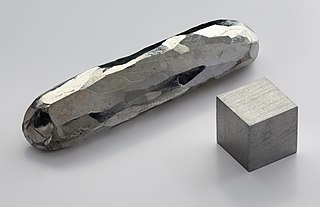
Cadmium is a chemical element; it has symbol Cd and atomic number 48. This soft, silvery-white metal is chemically similar to the two other stable metals in group 12, zinc and mercury. Like zinc, it demonstrates oxidation state +2 in most of its compounds, and like mercury, it has a lower melting point than the transition metals in groups 3 through 11. Cadmium and its congeners in group 12 are often not considered transition metals, in that they do not have partly filled d or f electron shells in the elemental or common oxidation states. The average concentration of cadmium in Earth's crust is between 0.1 and 0.5 parts per million (ppm). It was discovered in 1817 simultaneously by Stromeyer and Hermann, both in Germany, as an impurity in zinc carbonate.

Metalloprotein is a generic term for a protein that contains a metal ion cofactor. A large proportion of all proteins are part of this category. For instance, at least 1000 human proteins contain zinc-binding protein domains although there may be up to 3000 human zinc metalloproteins.

An endophyte is an endosymbiont, often a bacterium or fungus, that lives within a plant for at least part of its life cycle without causing apparent disease. Endophytes are ubiquitous and have been found in all species of plants studied to date; however, most of the endophyte/plant relationships are not well understood. Some endophytes may enhance host growth, nutrient acquisition and improve the plant's ability to tolerate abiotic stresses, such as drought and decrease biotic stresses by enhancing plant resistance to insects, pathogens and herbivores. Although endophytic bacteria and fungi are frequently studied, endophytic archaea are increasingly being considered for their role in plant growth promotion as part of the core microbiome of a plant.

Ophiacodontidae is an extinct family of early eupelycosaurs from the Carboniferous and Permian. Archaeothyris, and Clepsydrops were among the earliest ophiacodontids, appearing in the Late Carboniferous. Ophiacodontids are among the most basal synapsids, an offshoot of the lineage which includes therapsids and their descendants, the mammals. The group became extinct by the Kungurian or the Roadian, replaced by anomodonts, theriodonts, and the diapsid reptiles.
Phyllosticta batatas is a fungal plant pathogen infecting sweet potatoes.
Cercospora platanicola is a fungal plant pathogen. It causes leaf spot on the plane-tree.
Septoria caryae is a fungal plant pathogen. It infects species of the hickory genus.
Septoria platanifolia is a fungal plant pathogen infecting plane trees. It produces brown, circular spots that go on to develop grey centres with a darker halo.
Stemphylium bolickii is a plant pathogen infecting kalanchoes.
Monographella albescens is a fungal plant pathogen also known as leaf scald which infects rice.
Septoria secalis also known as Septoria Leaf Blotch is a fungal plant pathogen infecting rye.

A fungus is any member of the group of eukaryotic organisms that includes microorganisms such as yeasts and molds, as well as the more familiar mushrooms. These organisms are classified as one of the traditional eukaryotic kingdoms, along with Animalia, Plantae and either Protista or Protozoa and Chromista.

Coleosporium is a genus of rust fungi belonging to the family Coleosporiaceae. This diverse genus encompasses approximately 100 distinct species. The lifecycle of these fungi involves aecial stages, during which they parasitize various species of Pinus, while their telial occur on a number of angiosperms.

Ianthella basta is a species of fan-shaped sea sponge in the class Demospongiae. It is also known as the elephant ear sponge, paper sponge, or scroll sponge.

Paleontology or palaeontology is the study of prehistoric life forms on Earth through the examination of plant and animal fossils. This includes the study of body fossils, tracks (ichnites), burrows, cast-off parts, fossilised feces (coprolites), palynomorphs and chemical residues. Because humans have encountered fossils for millennia, paleontology has a long history both before and after becoming formalized as a science. This article records significant discoveries and events related to paleontology that occurred or were published in the year 2013.

Araripemydidae is a family of freshwater aquatic turtles belonging to the order Pleurodira, known from the Early Cretaceous of South America and Africa. The family contains two recognised monotypic genera, Araripemys and Taquetochelys, from the Santana Group of Brazil and the Elrhaz Formation of Niger, respectively, which date to the Aptian-Albian stages of the Early Cretaceous. They are consider to be the most basal lineage within the Pelomedusoides. They are thought to have been specialised suction feeders. Laganemys was named in 2013 but was later determined to be synonymous with Taquetochelys.
Tambacarnifex is an extinct genus of varanodontine synapsids known from the Early Permian Tambach Formation of Free State of Thuringia, central Germany. It was first named by David S. Berman, Amy C. Henrici, Stuart S. Sumida, Thomas Martens and Valerie Pelletier in 2013 and the type species is Tambacarnifex unguifalcatus.

Unenlagiidae is a proposed family of eumaniraptoran paravians that includes the subfamilies Unenlagiinae and possibly Halszkaraptorinae. Fossils of both subfamilies have been found in both Gondwanan and Laurasian deposits. The biology of the group suggests that some members were semiaquatic specialists.
A mycoparasite is an organism with the ability to parasitize fungi.

Citrus × amblycarpa is an artificial hybrid species of citrus lime. It has the hybrid formula Citrus daoxianensis × Citrus hystrix.










